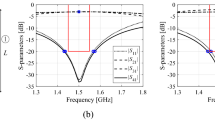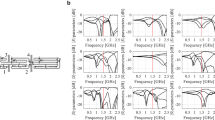Abstract
Integrated circuits operating in the millimetre-wave range require careful electromagnetic optimization of the passive networks to properly account for crosstalk and radiative effects, but also accurate and reliable statistical analysis to assess the impact of process induced variability on chip yield. These two requirements are typically computationally incompatible, since the simulation time required by electromagnetic analysis is too high to allow for multi-trial Monte Carlo statistical analysis. This work presents a parameterized surrogate approach to model the passive networks that allows for an efficient yet accurate electromagnetic-based variability analysis of microwave circuits. As a case study, we report the statistical analysis of a GaN/Si device at 28 GHz evaluating the impact of statistical variations of the matching network, under concurrent variation of two technological parameters, on device performance.
Access provided by Autonomous University of Puebla. Download conference paper PDF
Similar content being viewed by others
Keywords
- Parameterized behavioral models
- Process induced variability
- Electromagnetic simulation
- MMIC statistical analysis
1 Introduction
The adoption of higher frequency bands for both microwave telecommunication and radar systems [1, 3, 7, 15] poses new challenges in the design of monolithic integrated circuits (MMIC) in terms of electromagnetic (EM) coupling, stability issues and sensitivity to process variations, that could instead be neglected, or greatly simplified, at lower frequencies. The high cut-off frequency of the active devices together with the relatively low gain and output power achievable with single transistors/stages makes high-frequency MMICs densely integrated, with unavoidable EM coupling between adjacent structures [11, 13], hence making EM-based analysis and optimization a crucial design step.
At the same time, process induced variability (PIV) is a growing concern. Active devices capable of operating at millimetre-wave should feature very short gate-lengths, but such technologies are typically less mature and thus affected by larger technological variation. On the other hand, the effect of devices’ reactive parasitics become significant at high frequency, hence making the design of the matching networks increasingly challenging and the device performance much more sensitive to load variations. Both aspects increase the impact of PIV on yield, which may drop well below 50%, hence requiring a PIV-aware design approach [9].
Statistical analysis typically relies on the Monte Carlo (MC) approach, requiring accurate but also computationally efficient models for both the active devices and the passive networks [2, 5, 8]. Focusing on passives, to achieve accurate and reliable statistical results, an EM-based approach must be pursued, as it ensures a direct link between physical process parameters and network performance [4]. However, EM simulations are extremely time-consuming, even when resorting to planar-3D analysis for microstrip structure. Data arrays with several thousands of points should in fact be manipulated to achieve reasonable accuracy, requiring hours of simulation even on multi-core computers. This still widely limit the use of EM simulations in MMIC statistical analysis.
In [12] we proposed a parameterized reduced-order behavioral model as an efficient yet highly accurate approach for EM-based MMIC statistical analysis: few EM simulations, at properly chosen sets of parameter values, are enough to extract a mathematical model of the networks’s scattering matrix [6], then translated into an equivalent SPICE circuit [14] to be used within any RF CAD tools. As a case study, we consider the output matching network (OMN) of a commercial GaN/Si HEMT transistor for power amplifier (PA) applications at 28 GHz, presenting in [12] the statistical analysis of its small-signal matching performance. In this work we extend the analysis to the large-signal performance of the matched transistor, confirming model accuracy and showing the impact of OMN variations on the most relevant PA performance.
2 Modeling Approach and Case Study
The EM-simulated S-matrix of the network to be modeled is approximated with a rational barycentric function of the form [6]:
The basis functions \(\varphi _n(j\omega )\) are used to model the frequency dependence of the S-parameters and are represented by a set of N stable poles \(q_n\) [16]:
The coefficients are functions of the technological parameters \(\theta _i\), through Chebyshev polynomials basis functions \(\xi _l\):
As a case study, we consider a 6\(\,\times \,\)100 \(\upmu \)m GaN/Si HEMT device matched at output for maximum power at 28 GHz. The adopted technology is the 100-nm process from OMMIC [3]. The device is biased in shallow (25%) class AB and the optimum drain termination is \(Z_{Lopt}\approx (6+j11)\,\varOmega \), allowing for an output power in excess of 31.7 dBm with associated gain and efficiency better than 8.8 dB and 44%, respectively. The matching network, shown in Fig. 1, transforms the standard 50 \(\mathrm {\varOmega }\) load into \(Z_{Lopt}\) on a broad frequency range. The network is EM simulated in the 18 GHz-38 GHz range with 100 MHz frequency sampling: the simulation time is roughly 15 min, thus incompatible with a MC analysis, which would demand several days.
The considered variable parameters are the dielectric layer thicknesses for the two types of MIM capacitors (SiN and SiO\(_2\)) available in the process: based on the available statistical data, we assume a relative variance \(\sigma \) of 5% for the nitride thickness and 3% for the oxide thickness. The parameter space boundaries are set to \(\pm \sigma \) for both parameters: a deliberately reduced limit with respect to the classical \(\pm 3\sigma \) to assess the model extrapolation capabilities under larger variations during MC analysis. Only 10 EM simulations were required to extract the model coefficients with residual error less than \(10^{-3}\) [14]. As detailed in [12], the model demonstrates remarkable robustness against port impedance change, maintaining an accuracy within \(4\cdot 10^{-3}\) when simulating the S-parameters with \(Z^*_{Lopt}\) at the input port.
3 Results
The large-signal performance of the matched device is analyzed under continuous-wave excitation in the 25 GHz to 31 GHz range (1 GHz step), sweeping the input power from small-signal to saturation. The comparison between EM simulations (black lines) and model predictions (red symbols) are reported in the following figures: Fig. 2-top reports the performance at saturation over frequency for nominal (solid/circles) and two random (dash/crosses) parameter values. The accuracy is very good, as confirmed by the results shown in Fig. 2-bottom, reporting the rms errors at 10 randomly selected test points. The maximum errors in predicting the output power, drain efficiency and gain are lower than 0.28 dB, 2.3% points and 0.31 dB, respectively.
Figure 3 illustrates the extrapolation capabilities of the model. Figure 3(a) reports the output power at extrapolated parameter values, namely \(+3\sigma \) (solid/circles) and \(-3\sigma \) (dash/crosses): the agreement with EM simulations is still excellent. Figure 3(b) shows instead the output power at second (solid/circles) and third (dash/crosses) harmonics. Considering the small absolute value of these quantities, the agreement is still good. Remarkably, as detailed in Fig. 3(c), the proposed model extrapolates in frequency much better that any other built-in ADS extrapolation algorithms applied to narrow-band (18 GHz-38 GHz) EM simulations (blue curves).
Figure 4 reports the results of a 500-trial Monte Carlo simulation with uncorrelated variations of the two parameters, both featuring a gaussian distribution with \(\sigma \) relative variance. Except for gain, affected by constant symmetrical spread at all power levels, PIV most affects the performance at saturation where up to 1 dB of power/gain spread and 6% points of efficiency spread can be observed in the lower portion of the band. The dissipated power density, which determines the device temperature [10], is also reported in Fig. 5: at high power levels the spread reaches 250 mW/mm.
References
Bao, M., et al.: A 24–28-GHz Doherty power amplifier with 4-W output power and 32% PAE at 6-dB OPBO in 150-nm GaN Technology. IEEE Microw. Wireless Compon. Lett. 31(6), 752–755 (2021). https://doi.org/10.1109/LMWC.2021.3063868
Beleniotis, P., et al.: Statistical modeling of GaN hemts by direct transfer of variations to model parameters. In: EuMIC (2021). https://doi.org/10.23919/EuMIC50153.2022.9783780
Cidronali, A., et al.: System level analysis of Millimetre-wave GaN-based MIMO radar for detection of micro unmanned aerial vehicles. PIERS-Spring (2019). https://doi.org/10.1109/PIERS-Spring46901.2019.9017681
Donati Guerrieri, S., et al.: Efficient sensitivity and variability analysis of nonlinear microwave stages through concurrent TCAD and EM modeling. IEEE J. Multiscale Multiphys. Comput. Tech. 4, 356–363 (2019). https://doi.org/10.1109/JMMCT.2019.2962083
Donati Guerrieri, S., et al.: Bridging the gap between physical and circuit analysis for variability-aware microwave design: modeling approaches. Electronics 11(6), 860 (2022). https://doi.org/10.3390/electronics11060860
Grivet-Talocia, S., Trinchero, R.: Behavioral, parameterized, and broadband modeling of wired interconnects with internal discontinuities. IEEE Trans. Electromagn. Compat. 60(1), 77–85 (2018). https://doi.org/10.1109/TEMC.2017.2723629
Ishikawa, R., et al.: A 28-GHz-Band GaN HEMT MMIC doherty power amplifier designed by load resistance division adjustment. In: EuMIC (2021). https://doi.org/10.23919/EuMIC50153.2022.9783948
Manfredi, P., Canavero, F.G.: Efficient statistical simulation of microwave devices via stochastic testing-based circuit equivalents of nonlinear components. IEEE Trans. Microw. Theory Techn. 63(5), 1502–1511 (2015). https://doi.org/10.1109/TMTT.2015.2417855
Mao, S., et al.: A yield-improvement method for millimeter-wave GaN MMIC power amplifier design based on load-pull analysis. IEEE Trans. Microw. Theory Techn. 69(8), 3883–3895 (2021). https://doi.org/10.1109/TMTT.2021.3088499
Ramella, C., et al.: Thermal-aware GaN/Si MMIC design for space applications. In: COMCAS (2019). https://doi.org/10.1109/COMCAS44984.2019.8958104
Ramella, C., et al.: Electro-magnetic Crosstalk Effects in a Millimeter-wave MMIC Stacked Cell. In: INMMiC (2020). https://doi.org/10.1109/INMMiC46721.2020.9160341
Ramella, C., et al.: Efficient EM-based variability analysis of passive microwave structures through parameterized reduced-order behavioral models. In: EuMIC (2022). https://doi.org/10.23919/EuMIC54520.2022.9922958
Sangwan, V., et al.: High-frequency electromagnetic simulation and optimization for GaN-HEMT power amplifier IC. IEEE Trans. Electromagn. Compat. 61(2), 564–571 (2019). https://doi.org/10.1109/TEMC.2018.2820202
Triverio, P., et al.: A parameterized macromodeling strategy with uniform stability test. IEEE Trans. Adv. Packag. 32(1), 205–215 (2009). https://doi.org/10.1109/TADVP.2008.2007913
Wohlert, D., et al.: 8-watt linear three-stage GaN Doherty power amplifier for 28 GHz 5G applications. In: BCICTS (2019). https://doi.org/10.1109/BCICTS45179.2019.8972750
Zanco, A., et al.: Uniformly stable parameterized macromodeling through positive definite basis functions. IEEE Trans. Compon. Packag. Manuf. Technol. 10(11), 1782–1794 (2020). https://doi.org/10.1109/TCPMT.2020.3012275
Author information
Authors and Affiliations
Corresponding author
Editor information
Editors and Affiliations
Rights and permissions
Copyright information
© 2023 The Author(s), under exclusive license to Springer Nature Switzerland AG
About this paper
Cite this paper
Ramella, C., Zanco, A., De Stefano, M., Bradde, T., Grivet-Talocia, S., Pirola, M. (2023). Parameterized Surrogate Models of Microstrip Structures for Electromagnetic-Based Power Amplifier Design and Statistical Analysis. In: Cocorullo, G., Crupi, F., Limiti, E. (eds) Proceedings of SIE 2022. SIE 2022. Lecture Notes in Electrical Engineering, vol 1005. Springer, Cham. https://doi.org/10.1007/978-3-031-26066-7_8
Download citation
DOI: https://doi.org/10.1007/978-3-031-26066-7_8
Published:
Publisher Name: Springer, Cham
Print ISBN: 978-3-031-26065-0
Online ISBN: 978-3-031-26066-7
eBook Packages: EngineeringEngineering (R0)









